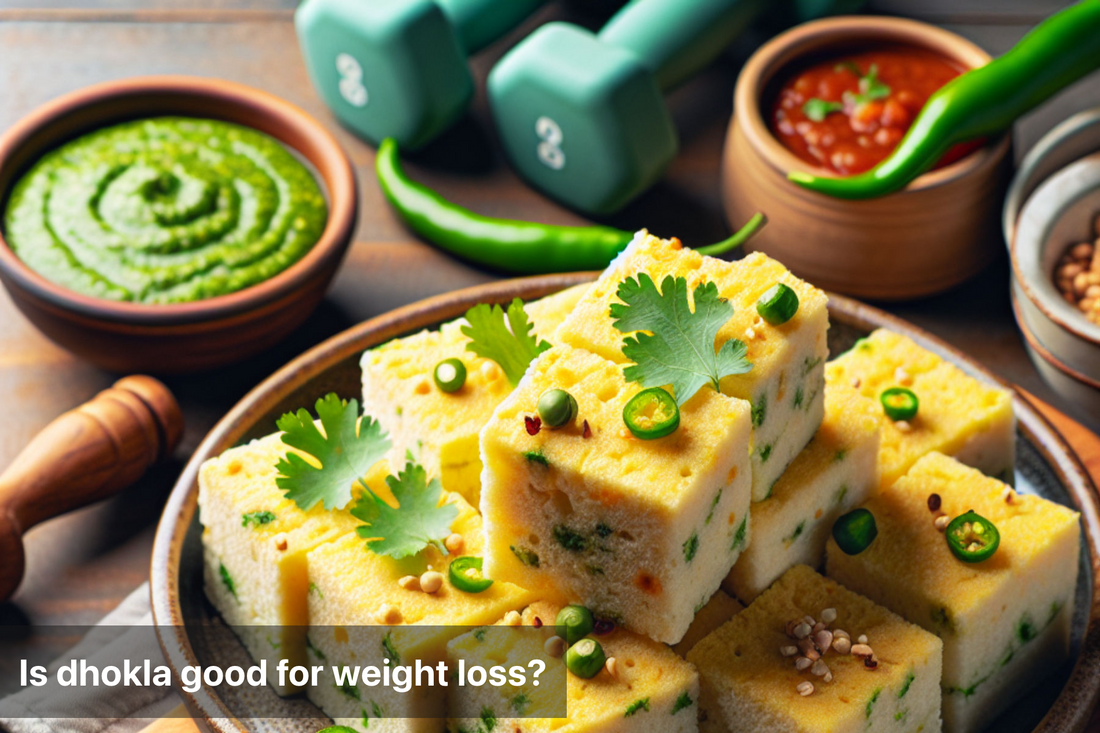
Is dhokla good for weight loss?
Share
Dhokla is a popular snack originating from the Indian state of Gujarat. This steamed, savory cake is made primarily from gram flour (besan) and is known for its light and fluffy texture. The dish is often spiced with ingredients such as mustard seeds, green chilies, and ginger, which add a unique flavor.
Historically, dhokla has been enjoyed during festivals and special occasions, but its rise in everyday meals reflects its versatility. With a growing emphasis on healthy eating, many are now considering snacks that are not just tasty but also nutrient-dense. This is where dhokla comes into play.
As the quest for weight loss continues to rise, individuals are increasingly seeking healthy snack options. Dhokla stands out for its low-calorie and high-protein content, making it an ideal choice for those looking to shed pounds. Unlike more traditional snacks, dhokla can provide satiety without excessive calories. Its ingredients, primarily chickpea flour, are known to be high in fiber, which can promote digestive health and keep you feeling full longer.
Incorporating dhokla into your diet could be a simple yet effective way to maintain your weight loss goals while enjoying flavorful food.

Nutritional Breakdown of Dhokla
Here’s the nutritional breakdown of a 100-gram serving of plain steamed dhokla:
Nutrient |
Amount per 100g |
|---|---|
Calories |
160 kcal |
Carbohydrates |
25 g |
Protein |
7 g |
Fat |
3 g |
Dietary Fiber |
2 g |
Sodium |
300 mg |
Iron |
1.2 mg |
Calcium |
20 mg |
Health Benefits of Dhokla
Dhokla can be a great addition to a weight-loss diet for the following reasons:
1. Low Calorie Density
Dhokla is steamed rather than fried, which significantly reduces its calorie content. This allows you to enjoy a filling snack without consuming excessive calories.
2. Rich in Protein
The use of chickpea flour (besan) in dhokla provides a good amount of plant-based protein. Protein is essential for weight loss as it keeps you fuller for longer, curbs hunger, and aids in muscle preservation.
3. High in Fiber
Fiber in dhokla improves digestion and promotes a feeling of fullness. This prevents overeating and helps maintain a calorie deficit for weight loss.
4. Low Glycemic Index (GI)
Dhokla has a low glycemic index, meaning it releases glucose into the bloodstream slowly. This helps regulate blood sugar levels and prevents spikes in hunger.
5. Good for Digestion
The fermentation process used in making dhokla enhances its digestibility and promotes gut health by introducing beneficial probiotics.
“Dhokla is proof that healthy eating doesn’t have to be boring; it’s light, nutritious, and perfect for your weight-loss journey.” adds Health Coach Madhavi Mahajan (PG in Sports Science, Fitness & Nutrition).
How to Incorporate Dhokla into a Weight Loss Diet
1. Choose the Right Ingredients
Opt for whole-grain flours or add millet flour for an even healthier version.
Avoid adding excessive sugar or oil in the batter.
2. Portion Control
While dhokla is healthy, consuming it in moderation is key. A serving size of 2-3 pieces per snack is ideal.
3. Pair It Smartly
Pair dhokla with green chutney made from mint, coriander, and lime for added nutrients and flavor.
Avoid calorie-dense accompaniments like fried snacks or sugary drinks.
4. Time It Well
Dhokla is best consumed as a breakfast item or evening snack. Eating it late at night might not be ideal for digestion.
Healthy Dhokla Variations
Variation |
Key Ingredients |
Benefits |
|---|---|---|
Oats Dhokla |
Oats, curd, spices |
High in fiber and supports weight loss |
Ragi Dhokla |
Ragi (finger millet), chickpea flour |
Rich in calcium and low in calories |
Moong Dal Dhokla |
Yellow lentils, ginger, green chilies |
High in protein and low GI |
Spinach Dhokla |
Spinach puree, chickpea flour |
Rich in iron and vitamins |

Potential Drawbacks to Consider
High Sodium Content: Dhokla may contain a significant amount of sodium, particularly when store-bought. Monitor your salt intake if you have hypertension.
Overconsumption: Although healthy, eating too much dhokla can add to your calorie intake and hinder weight loss.
Added Ingredients: Be cautious about added sugar and excessive oil in commercially prepared dhokla.
Summary
Dhokla emerges as an excellent snack option for those pursuing weight loss. Its unique combination of ingredients provides a low-calorie yet nutritious alternative to traditional snacks. With its high protein content and low-fat levels, dhokla supports muscle maintenance while assisting in weight management.
The fermentation process used in making dhokla enhances its digestibility, which promotes better nutrient absorption and gut health. The presence of fiber also plays a crucial role in keeping you full for longer, making it easier to control hunger pangs throughout the day.
Incorporating dhokla into your diet can be simple. Pair it with green chutneys or salads to elevate nutrition without adding excessive calories. Moreover, serving moderation is key, as maintaining portion control can help achieve your weight loss goals while still enjoying your favorite snacks.
FAQs
1. Can I eat dhokla daily while trying to lose weight?
Yes, you can include dhokla in your daily diet, provided you control the portion size and pair it with healthy sides.
2. Is store-bought dhokla healthy?
Store-bought dhokla might contain added preservatives, sugar, and oil. Homemade dhokla is a healthier choice.
3. Can I eat dhokla for dinner?
Dhokla can be consumed for dinner, but it’s better to have it earlier in the evening to ensure proper digestion.
4. Which type of dhokla is best for weight loss?
Variations like oats dhokla, ragi dhokla, or spinach dhokla are more nutritious and ideal for weight loss.
5. Does fermentation make dhokla healthier?
Yes, fermentation enhances nutrient absorption and adds probiotics, which support digestion and overall health.
